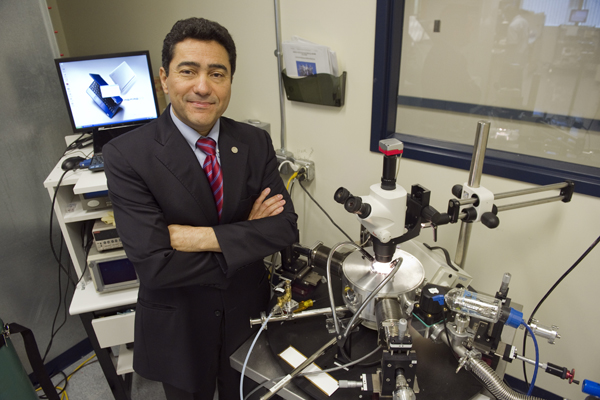3Qs: The 3-D printing of tomorrow

Ahmed Busnaina, the William Lincoln Smith Professor and director of the NSF Nanoscale Science and Engineering Center for High-rate Nanomanufacturing at Northeastern, has developed a method called directed assembly that he calls the 3-D printing of tomorrow. It is faster, cheaper, and more versatile than traditional 3-D printing, and he said it could enable a wave of innovation not currently feasible. Here, we asked Busnaina to describe this process and its potential impact in areas such as health, electronics, and the environment.
What is directed assembly and how does it differ from traditional 3D printing?
The modern 3-D printer is basically a specialized ink-jet printer. It uses a printer head with special ink that could contain a polymer, particles, or nanotubes suspended in solution, or really anything. It prints line by line, so products requiring higher resolution or large areas take a very long time.
What we have developed at our center is a system that’s like newspaper printing or printing money, where you have a big plate, you put ink on it, and bang: One hit, you’re done. Only here, the ink is made of very small and very sensitive nanoparticles attracted to the template using electrophoresis, so we have to pick exact dimensions and materials.
We put a template with a pattern represented by nanowires into a solution that is similar to ink, but very dilute. Then we apply a couple of volts so that nanoparticles in the ink are drawn to the nanowires. Then we take out the template and transfer the assembled nanoparticles to a surface of either a hard or flexible substrate. That would be the first layer of a device, which takes about a minute or two. A sensor may have just a few layers, where advanced electronics may have 10 layers or more.
What advantages does directed assembly have over 3D printing?
For low-cost, low-end products, 3-D printers are very good but they are slow—it can take days to print a single product. But with directed assembly, we can do low-cost, high-end products, and we can do them very quickly. So, directed assembly will be very valuable for high-value devices like sensors, advanced electronics, energy harvesting, or batteries. It might also be used for tissue engineering and printing biomaterials like cells or proteins.
Directed assembly allows 3-D printing to be faster, cheaper, and multiscale. It can do nano, micro, and macro simultaneously over a large area. No 3-D printer can do that; this is beyond the current 3-D printing technology. This will reduce the cost of expensive electronics such as an iPhone for less than $10 and sensor systems for a fraction of a dollar. These could be sensors for health, the environment, infrastructure, water resources, anything. They will make advanced products affordable to people in all income classes, not just high-income populations or countries.
What we’re trying to do is make high-value things, such as sensors, energy-harvesting devices, or phone displays, using this technology, which costs 1 percent of conventional manufacturing. That also means you can make all kinds of devices by design, printing things exactly to specifications—even down to the nanoscale (one thousand times smaller than a human hair).
For example, we developed an energy-harvesting device that can use any heat source—even body heat—to charge a sensor or a phone. An antenna absorbs heat and converts it to current. We print it using carbon nanotubes for the ink. This kind of device would not be possible with traditional 3-D printing—it just can’t go that small.
What would a future with directed assembly look like?
Advanced electronics fabrication facilities cost as much as $10 billion each. Only a very small number of companies—maybe four or five in the world—can presently afford that. Even IBM has gotten out of that business. If they need advanced electronics, they contract out. As a result, the cost for about 40 simple basic chips using older technology is about $55,000. The price goes down if you buy in bulk, but developers aren’t going to ask for a million chips.
Our technology is very low cost, about 1 percent of conventional electronics manufacturing, where the equipment and methods are expensive. With our approach, once you make one of our templates (which are not cheap to make), you can use it thousands of times and the method is very simple. Also, the energy cost is very sustainable—you only need two or three volts! You don’t need high temperatures, you don’t need vacuum, so there’s very low energy consumption and infrastructure costs. This turns everything on its head.
You could build a basic fabrication facility for a few million dollars instead of billions. All the companies that have gotten out of electronics manufacturing could now afford to get back into it. And it spurs a wave of innovation because anyone can make something and test it. Inexpensive flexible circuits, thin-film batteries, and medical biosensors, for example, are all possible using this technology. So far, no advanced electronics or chips have been made using traditional 3-D printing.





